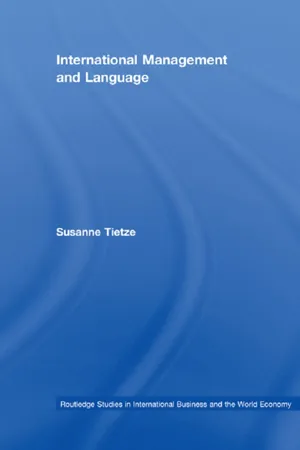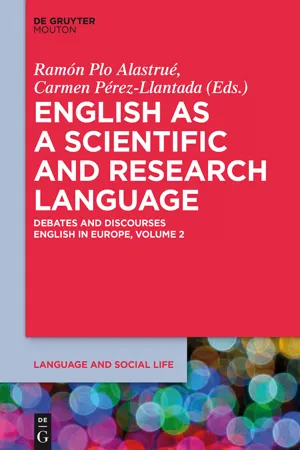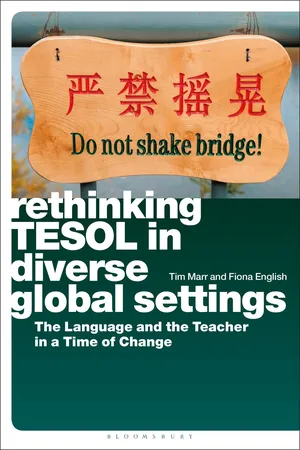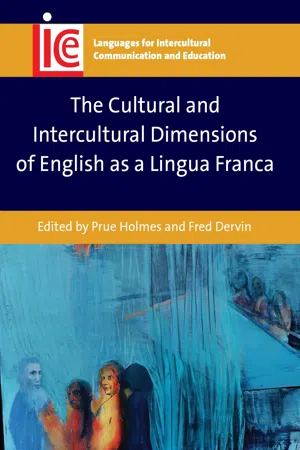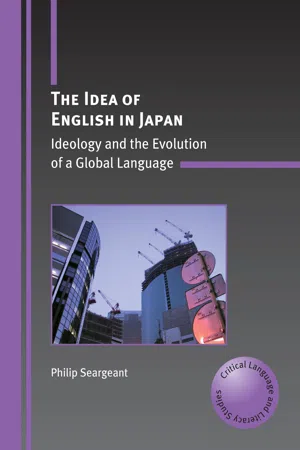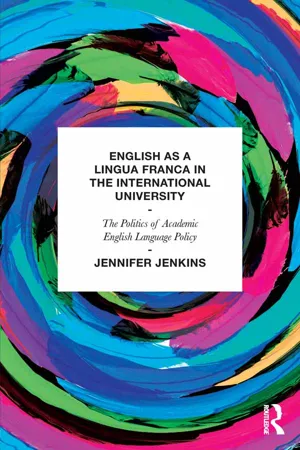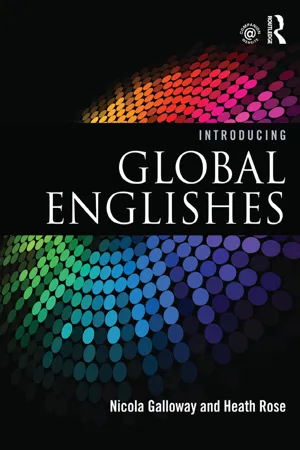Languages & Linguistics
English as a lingua franca
English as a lingua franca refers to the use of English as a common language for communication between speakers of different native languages. It is often used in international business, diplomacy, and academia. As a result, English has become a global language, facilitating communication and understanding across diverse linguistic and cultural backgrounds.
Written by Perlego with AI-assistance
11 Key excerpts on "English as a lingua franca"
Learn about this page
Index pages curate the most relevant extracts from our library of academic textbooks. They’ve been created using an in-house natural language model (NLM), each adding context and meaning to key research topics.
- eBook - ePub
- Susanne Tietze(Author)
- 2013(Publication Date)
- Routledge(Publisher)
5 English as the global lingua franca
DOI: 10.4324/9780203929353-5This chapter provides an exploration of English as the contemporary ‘lingua franca’ of global reach. It provides some background to and reasons for the emergence and ascent of English as a shared communicative tool. The role and rise of English as such a communicative tool has been investigated from different positions, and different explanations for its augmented status have been given – e.g. it is associated with the economic dominance of the United States, increases in mobility and travel of large parts of the population, the emergence of networked information societies as well as with the history of British colonialism and imperialism. As the role and function of English have been discussed to an extent in the previous chapter and will again be discussed in the following chapter, this chapter remains a relatively brief one, as it links the themes of the previous chapter with those of the following chapters in part two, which provides applications of the discussed themes.English as the contemporary lingua franca
Vandermeeren (1999: 276) defines a lingua franca as ‘an idiom that nonnative speakers use with other non-native speakers, rending it a foreign language for all parties concerned’.1 Many languages have been used as such shared communicative tools, for example Arabic, French, Greek, Latin, Persian, Portuguese, Russian to name but a few (for a detailed historical analysis see Ostler 2005 ). Many lingua francae extend only over a small territory, linking, for example the trading populations of just a few countries. By contrast, Latin was more widely used throughout the Roman Empire, although its use was mainly contained at the level of government and not everyone spoke or used Latin for their daily interactions.According to Crystal (2003) - Mercedes Durham(Author)
- 2014(Publication Date)
- Multilingual Matters(Publisher)
English is widely used on the European continent as an international language. Frequently conferences are conducted in English (and their proceedings published in English) when only a few of the participants are native speakers. At such conferences the English spoken often shows features at variance with the English of England but shared by the other speakers. (Ferguson, 1981: xvi)It is not just in Europe and at conferences that such language use occurs, but in some form or other in most parts of the world. This is not to imply that English is used everywhere (despite what some English-speaking tourists may think or desire), but rather that if a non-local language is used for conversation, it is likely to be English. The ubiquity of English affects its overall perception and its more general use.Before discussing the effects of ELF on speakers, native and non-native, I will address the important preliminary question of whether English is like other lingua francas. Broadly speaking, a lingua franca is a language used by speakers of different languages to communicate with each other (Meierkord, 2006). People have used lingua franca languages for trade, for diplomacy and for a wide range of other reasons throughout history. In some instances the language used as a lingua franca was the native language of one group and a second or third language of another group, but often lingua francas were chosen as neutral languages between speakers of different languages. Additionally, mixed language varieties such as pidgins and creoles were sometimes used as lingua francas. Pidgins are languages which arise through the contact of speakers of two or more languages using a language that is native to none of the groups. A pidgin is said to be a language with no native speakers, and a creole is a pidgin which has acquired native speakers (this is a somewhat simplified explanation of the difference between pidgins and creoles, but suffices for the purposes here; see Todd, 1991: 48ff). To give two brief examples of lingua francas: Latin was widely used as a lingua franca across the Roman Empire and French was a vital tool within diplomatic circles across Europe (and Russia) from the 17th century until the 20th century. Often the people using a lingua franca are not as proficient in it as native speakers are, but because the main purposes of lingua franca use have to do with communicative urgency and a desire to get one's point across, this is not generally seen as problematic.- eBook - ePub
- Ramón Plo Alastrué, Carmen Pérez-Llantada, Ramón Plo Alastrué, Carmen Pérez-Llantada(Authors)
- 2015(Publication Date)
- De Gruyter Mouton(Publisher)
Firth (1996) called “let it pass” principle. It means that they do not disturb the communicative interaction but they use the context to negotiate the meaning of an unintelligible item. The list of pragmatic strategies used by multilingual speakers is quite extensive. When English is used as a contact language, multilingual speakers often rely on rephrasing, repetition and overt negotiation. In extreme cases they are even ready to change the topic of a conversation to avoid misunderstanding. Moreover, they are quite creative in overcoming the linguistic barriers, for example, they resort to humour, evoke the shared feelings of non-nativeness and distance themselves from the linguistic norms. At the supra-sentential level multilinguals facilitate communication by resorting to such strategies as:–segmentation – using shortened utterances into clausal or phrasal segments which form the basic informational units; –regularization – applying the focused information at the front of the sentence;–monitoring their syntax to facilitate intelligibility (cf. Canagarajah 2011 ).So, in a multicultural context it is quite reasonable to let multilingual students apply norms typical for English as a lingua franca instead of relying on almost unachievable models of native speakers. So what is “English as a lingua franca”?2.1 The linguistic research on English as a lingua franca
ELF performs the role of a “contact language” between speakers who share a common tongue not a common culture and for whom English is the chosen foreign language of communication (Firth 1996 : 240). Similarly, Jenkins (2009: 200) defines ELF as “the common language of choice, among speakers who come from different linguacultural backgrounds”. In general, the term “lingua franca” denotes a common language used by people who do not share a mother language. According to the Encyclopaedia Britannica - eBook - ePub
Rethinking TESOL in Diverse Global Settings
The Language and the Teacher in a Time of Change
- Tim Marr, Fiona English(Authors)
- 2019(Publication Date)
- Bloomsbury Academic(Publisher)
It’s worth following this. First, the definition of lingua franca expanded to include a natural language (i.e. not a pidgin or an artificial code, but an ethnic/national language like, say, Arabic or Portuguese or Tamil) when this is being used as a link language between speakers of two different languages, but is not the mother tongue of either of them. So that might include, for example, an Igbo-speaking Nigerian and a Hausa-speaking Nigerian using English to communicate, or a Moroccan speaking English to a Dane. It would include Tim, a native English speaker, having a conversation in Spanish with a Swiss person, as happened the last time he was on a plane bound for South America. Next – and this is the tricky bit – the term was widened by some linguists to embrace any language used between speakers who do not share the same mother tongue, even when it is the native language of one of them. This means us speaking our own native English with the Nigerian, Swiss, Moroccan or Dane, for all of whom it is a second or foreign language. It is this extension of meaning that has been particularly associated with the field of ELF studies (see Kimura 2017: 268). The outcome of all this widening of definitions, predictably, is a situation in which usage is ‘partly inconsistent and can be misleading’ (Brosch 2015: 71). This is putting it mildly. As will become apparent if we look at just a few of the definitions of the term, there exists in fact a chaotic jumble of usage. The Oxford English Dictionary, for instance, gives as one of its definitions of lingua franca that it is a ‘mixed jargon’, but allows several other definitions. Jenkins (2007: 1) insists that LFs are always mixed – that hybridity is a fundamental characteristic of such codes. Samarin (1972) does not hold this to be the case at all. Dakhlia (2008) allows two meanings: a ‘normal’ or natural, ethnic/national language used as a contact language, or a mixed, pidginized code with a temporary life span - Prue Holmes, Fred Dervin(Authors)
- 2016(Publication Date)
- Multilingual Matters(Publisher)
Introduction – English as a lingua franca and Interculturality: Beyond Orthodoxies 1Prue Holmes and Fred Dervin ELF and Interculturality: Two Different Fields that Have Much in CommonWhen we started working on this book project, we envisaged a publication about the links between the use of lingua francas and interculturality in our post-national and ‘glocal’ (both global and local) worlds that would, in a sense, follow up on Byram’s (2008) idea that language – including lingua franca language – is somehow detached from culture and contexts of interaction. As the project advanced, however, we attracted very few contributions that dealt with lingua francas other than English. Although the world is ‘full’ of lingua francas used within and across national and many other types of borders, English as a lingua franca (ELF) as a field of research has attracted a lot of attention worldwide (Bowles & Cogo, 2015; Jenkins et al. , 2011; Mauranen & Ranta, 2009; Seidlhofer, 2011). We therefore decided to concentrate on ELF, hoping that the discussions provoked by the chapters in this book might also trigger debates in relation to other lingua francas such as Arabic, Chinese Mandarin, Spanish and French, but also Esperanto – or any other language, for that matter, as all can serve as lingua francas today. The need for these languages to be examined is dire (Dervin, 2010). Interculturality is not exclusive to English. Thus, just as O’Regan in his commentary chapter at the end of our book aims to ‘open a new reading’ of the term ‘ELF’, we too aim to open up discussion of the cultural and intercultural in lingua franca communication.It is of course obvious that English is today’s lingua franca par excellence , with 375 million people speaking it as their first language and one in four of the world’s population speaking it as a second/foreign language (Crystal, 2012). Although many aspects of the use of ELF have been researched, interculturality seems to have been neglected, or at least discussions on interculturality in relation to ELF do not appear to be in line with current perspectives on and understandings of the term in fields such as language education, applied linguistics, inter-/multicultural education and intercultural communication. For example, earlier attempts to examine lingua francas have tended to focus more on the linguistic, syntactic, phonological and pragmatic elements of a language, as well as intelligibility and other sociolinguistic features (see for example McGroarty, 2006, in the special issue of The Annual Review of Applied Linguistics ; although the work of Canagarajah (2006) in that special issue begins to assert the need to address historical associations of lingua francas, discussions are largely framed within applied linguistics theoretical approaches). Jenkins et al.- eBook - ePub
The Idea of English in Japan
Ideology and the Evolution of a Global Language
- Philip Seargeant(Author)
- 2009(Publication Date)
- Multilingual Matters(Publisher)
Often today, if one talks of the teaching of English, it is with this concept hovering somewhere in the background, and explicit promotion of the language, especially in parts of the world where its influence is historically slight, draws directly upon this idea as one of the most positive factors in the language's favor. The perception is that to have English is to have access to the wealth of the world that is otherwise obscured behind linguistic barriers. As one recent policy document from Japan asserts, ‘knowledge of English as the international lingua franca equips one with a key skill for knowing and accessing the world’ (CJGTC, 2000a: 10). In actual fact, there are two distinct issues here, despite the inevitable melding that occurs between them. There is the spread of English historically, culturally and diversely; then there is the benefit that English can, in theory, bring for enhanced linguistic mobility – an idea which leads, by small increments, to the concept of the universal tongue. And while this conceptual confusion may be inevitable – especially within the context of globalization, which preaches the acute importance of communication across cultures – it is also problematic. For immediately we can see that while English in the world is far from unitary in any aspect of its existence, a universal language has, as its one essential characteristic, the function of uniting in dialogue the speakers of disparate languages, and of providing an antidote to the confusio linguarum which has bedevilled human civilization since its inception. To unite by means of something that is itself only unitary in the imagination seems logically impossible. And yet discourses of English across the globe have become entangled with this persuasive discourse of English as a universal tongue, and the result is a complex of both practical and ethical issues - eBook - ePub
Linguistic Justice
Van Parijs and his Critics
- Helder De Schutter, David Robichaud, Helder De Schutter, David Robichaud(Authors)
- 2017(Publication Date)
- Routledge(Publisher)
lingua franca takes hold in that domain and we generalise the model, there are consequences for those on whom the burden of learning a new language is imposed. I return to these issues below.Another assumption lies behind the maxi-min strategy, at least as part of an explanation of why English is emerging as the lingua franca. Why is English a better bet in Europe than German or French? Because anglophones are often part of the conversation, and the one sure thing is that most of them will speak only English. Monolingualism is less true of native speakers of other European languages. The more others adapt to anglophone incompetence or intransigence, the more the salience of English is entrenched.Those willing to learn another language, even rudimentarily, will be at a disadvantage in the company of those who refuse to do so, at least if the willing learners have an interest in their language becoming the lingua franca. In principle, willingness to learn ought to be equally distributed amongst all peoples, but in practice willingness or lack thereof often stems from previously entrenched forms of social inequality. Anglophones do not just happen not to speak a second or third language; they largely exist in a social and political culture that has entitled them not to do so, and they often feel no obligation to meet others even half way.Absent these forms of social power, and thus privilege, it is questionable whether a single lingua franca would emerge at all, let alone that it would be English. To the extent that Van Parijs acknowledges this dynamic in the parable of his tussle with his father-in-law over the hoovering (2011, pp. 51–52), he treats it as grounds for compensation for an unfair outcome rather than a reason to prevent unfair outcomes from emerging. If a particular state of affairs is inevitable, though unfair, we should just figure out how to go forward as fairly as possible. But if that situation might not exist if not for unjust power relations that brought it into being, it is less clear that the only task of a theory of linguistic justice is to determine how best to compensate for the way things turned out. This is especially so where the result has not yet quite emerged; in this context, the decision to treat it as inevitable will itself make its emergence a foregone conclusion. The remedy for the injustice of one household member doing all the hoovering is, prima facie - eBook - ePub
English as a Lingua Franca in the International University
The Politics of Academic English Language Policy
- Jennifer Jenkins(Author)
- 2013(Publication Date)
- Routledge(Publisher)
2THE SPREAD OF English as a lingua franca
Lingua francas and the emergence of ELF
When people first come across the term ‘English as a lingua franca’ or its acronym ‘ELF’, they tend to assume that it refers to a completely new phenomenon. However, this is by no means the case: both lingua francas in general and ELF in particular have existed in various forms for many centuries. On the one hand, as the literature on ELF often points out (e.g. House 2003, Knapp and Meierkord 2002, and more recently, Jenkins, Cogo, and Dewey 2011, Seidlhofer 2011), languages such as Arabic, Greek, Latin, Portuguese, and Sanskrit have performed the function of lingua francas at various times in history. On the other hand, English itself has served as a lingua franca in the past, and continues to do so nowadays, in many of the countries that were colonized by the British from the late sixteenth century on (often known collectively as the Outer Circle following Kachru 1985), such as India and Singapore. And besides ELF's shared background with other lingua francas, it also has much in common with the ways in which all natural languages develop, as will be discussed later in the chapter.What is new about ELF, however, is the extent of its reach. This goes well beyond the relatively narrow spreads, both geographically and domain-wise, of other lingua francas, including, at least geographically, the earlier lingua franca uses of English. And because this extensive spread brings with it, by definition, so much diversity among ELF speakers in terms of their linguistic (and cultural) backgrounds, a further difference has emerged between ELF and other lingua francas: ELF's uniquely flexible nature. As House (2003: 557) notes, the original term ‘lingua franca’ (which, itself comes from the Arabic ‘lisan-al-farang’) simply referred to “an intermediary language used by speakers of Arabic with travellers from Western Europe” (see also Kachru 1996). This early meaning, House continues, “was later extended to describe a language of commerce, a rather stable variety with little room for individual variation ” (ibid.; my italics).1 This kind of lingua franca is thus of a very different order from ELF, whose speakers in any given interaction are drawn from a vast potential first language pool that encompasses the whole of the Expanding Circle, while not excluding members of the Inner and Outer Circles2 - eBook - ePub
- Nicola Galloway, Heath Rose(Authors)
- 2015(Publication Date)
- Routledge(Publisher)
Chapter 3 that the globalization of English has received much attention. However, globalization – and the use of ELF specifically – has also influenced the language itself. ELF as a phenomenon has been described throughout this book, but in this chapter we explore what happens to English when it is used as a lingua franca. In doing so we examine past and current research trends, criticisms and misunderstandings, and the future directions of ELF research.Table 7.1Conceptual differences between EFL and ELF Objectives
Source: Seidlhofer, 2011, p. 18Foreign language (EFL) Lingua franca (ELF) Lingua-cultural norms Objectives Pre-existing, re-affirmed Integration, membership in native-speaking community Ad hoc, negotiatedIntelligibility, communication in a non-native speaker or mixed non-native speaker–native-speaker interactionProcesses Imitation, adoption Accommodation, adaptation We begin in Section 7a with a theoretical and descriptive overview of ELF research, focusing on pronunciation and lexicogrammar. Section 7b examines the pragmatics of ELF communication, highlighting the shift in research focus away from the documentation of regularities or common features in early days. ELF research has been conducted in a number of domains; Section 7c provides an overview of the business domain, business English as a lingua franca (BELF). ELF throws a new perspective on language change, and ELF also lets us revisit English and reconceptualize many of the fundamental concepts underpinning language in general. In Section 7d we return to many of the concepts that have been introduced at various points in the book, such as language change and variation, language contact, standardization, language varieties, and ownership. ELF research has become the subject of considerable debate and criticism. We end in Section 7d - eBook - ePub
Innovation in Language Teaching and Learning
The Case of Japan
- Hayo Reinders, Stephen Ryan, Sachiko Nakamura, Hayo Reinders, Stephen Ryan, Sachiko Nakamura(Authors)
- 2019(Publication Date)
- Palgrave Macmillan(Publisher)
© The Author(s) 2019Begin AbstractH. Reinders et al. (eds.)Innovation in Language Teaching and Learning New Language Learning and Teaching Environments https://doi.org/10.1007/978-3-030-12567-7_8What Does ‘Teaching English as a lingua franca’ Mean? Insights from University ELF Instructors
Keywords English as a lingua franca (ELF) English as a Foreign Language (EFL) Global human resources Under-enrollmentEnd AbstractIntroduction
In many Japanese universities, English language teaching (ELT) programs are organized around the concept of an ‘international language,’ and they aim to equip their students with a native-like ability. The view that the English used by native speakers of English (NESs) is the international language usually remains unchallenged. This chapter focuses on a university ELT program that has challenged this view and adopted ‘English as a lingua franca’ (ELF) as its target language (hereafter ELF program). Although the adoption of this unconventional concept of ELF was to better prepare students for the demands of global communication, its fundamental motivations often seemed mainly managerial: Japan’s rapid demographic changes urged the university to make the radical pedagogical choice in order to avoid under-enrollment . This chapter attempts to describe the tension between the academic and managerial aspects of this innovation and what difficulties it brought to instructors who were in charge of day-to-day teaching on the ELF program. The first part of the chapter looks into the academic aspect of the adoption by examining differences between the conventional concept of English as an international language and ELF. Then, the chapter moves on to background reasons for the adoption of ELF and details of the program in order to scrutinize the managerial aspect. The latter part of the chapter investigates the instructors’ interpretations of the adoption of ELF: how they responded to and tried to adapt to this ostensibly radical pedagogical decision is examined based on their interpretations of the experience - eBook - ePub
- Telma Gimenez, Michele Salles El Kadri, Luciana Cabrini Simões Calvo(Authors)
- 2017(Publication Date)
- De Gruyter Mouton(Publisher)
Journal of English as a lingua franca 1(1). 141–170.Firth, Alan. 1996. The discursive accomplishment of normality – on lingua franca English and conversation analysis. Journal of Pragmatics 26(2). 237–259.Foucault, Michael. 1983. Postface: The subject and power. In H.L. Dreyfus & P. Rabinow (eds.) Michel Foucault: Beyond structuralism and hermeneutics . Chicago, IL: University of Chicago Press.Foucault, Michael. 2002. A ordem do discurso [Orders of Discourse] . São Paulo: Loyola.Harris, Roy. 1998. Introduction to integrational linguistics . Oxford: Pergamon.Harris, Roy. 1990. On redefining linguistics. In H. Davis & T. Taylor (eds.), Redefining linguistics , 18–52. London: Routledge.Jenkins, Jennifer. 2000. The phonology of English as an International Language. Oxford: Oxford University Press.Jenkins, Jennifer. 2009a. World Englishes: A resource book for students . (2nd edn.). London: Routledge.Jenkins, Jennifer. 2009b. English as a lingua franca: interpretations and attitudes. World Englishes 28(2). 200–207.Jenkins, Jennifer, Alicia Cogo & Martin Dewey. 2011. Review of developments in research into English as a lingua franca. Language Teaching 44(3). 281–315.Jordão, Clarissa M. 2006. O Ensino de Línguas Estrangeiras - de código a discurso. In V. Vaz Boni (Org.). Tendências Contemporâneas no Ensino de Línguas . União da Vitória: Kaygangue.Jordão, Clarissa. M. 2014. ILA - ILF - ILE - ILG: Quem dá conta? Revista Brasileira de Linguística Aplicada 14(1). 13–40.Kachru, Braj B. 1986. The alchemy of English: The spread, functions and models of nonnative Englishes (1st edn.). Oxford: Pergamon.Kachru, Braj. B. 1992. Teaching World Englishes. In B. B. Kachru (ed.), The other tongue. English across cultures (2nd edn), 355–365. Urbana, IL: University of Illinois Press.Kachru, Braj B., Yamuna Kachru & Cecil. L. Nelson (eds.). 2006. The handbook of World Englishes
